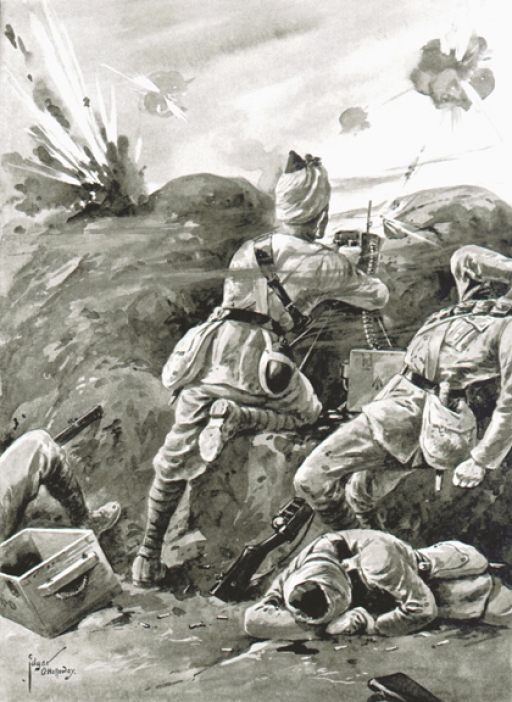Soldiers of the Lahore Division of Britain’s colonial Indian Army went into action in Belgium for the first time on October 24th 1914. CN writer Christopher J. Harvie discusses a critical moment in the First Battle of Ypres.
Eventually contributing over one million troops, the British Indian Army would become the largest source of volunteers from the Empire. The first units to the Western Front in 1914, parts of the Indian Corps of Indian Expeditionary Force A, arrived at a most desperate moment.
In two months of open warfare costly battles had been fought back and forth in the hinterlands of France and Belgium. Constant contact had worn the armies down, shrunk their reserves of manpower and turned the war into not much more than a grappling match.
“Ypres became a grinding battle of willpower more than anything else. Through heavy rains along ground already wet and miserable and days growing colder, villages, woods and shallow trenches were taken and retaken. For almost four weeks of assaults and counter attacks, wearied men on both sides continued to hammer away at each other in a dogged and brutal fashion.”
(“First Light of Dawn”, author’s post If Ye Break Faith)
Gone by this point were the sweeping, grand manoeuvres of large armies in the field. The conflict had now devolved to isolated skirmishes, both sides attempting to probe for the weak link that would open the ground wide again.
By mid-October, the low-lying, difficult terrain of Belgian Flanders was the only place remaining where either the Germans or the Allies might break through. The remainder of the front had settled into mutual defensive works or would be deliberately flooded by order of the Belgian King. To date, the BEF had incurred 57,000 casualties and in some places around the Ypres area of operations were so depleted as to be at a 12:1 numerical disadvantage.
India Arrives
On October 20th 1914, the Indian Cavalry Corps with the 3rd (Lahore) and 7th (Meerut) Divisions began to reach the front. With an immediate need to shore up the thinly held salient, the 3rd Division, having arrived first, was broken up. Individual brigades and battalions were sent where they were most needed. The Division would be blooded almost simultaneously in three separate engagements at La Bassée, Messines and Armentières.
Despite the home garrison being in the predominantly Punjab city of Lahore, which is now within Pakistan, the 3rd Division (referred to by its nominative “Lahore Division” on the Western Front to avoid confusion with the BEF’s 3rd Division) was composed of battalions of wide backgrounds including men of Baloch, Dogra, Ghurkha, Pathan, Punjabi and Sindhi heritage. It came into its pre-war organisation during Kitchener’s reforms of the Indian Army in 1904, as part of Northern Command, with the Jullundur, Sirhind and Ambala brigades
“Where is my Division?”
The deconstruction of the Lahore Division wasn’t a discourtesy; at this point larger formations were of little use and these troops as with some British units became detached and used as “flying squads” to shore up the line during a very fluid situation. Lieutenant General Wilcox, GOC Indian Corps, noted in his diary in late October how the Division was taken apart:
“Where is my Lahore Division? Sirhind Brigade detained in Egypt. Ferozepore Brigade: somewhere in the north, split up into three or four bits. Jullundur Brigade: Manchesters gone south to (British) 5 Division (this disposes of only British unit) 47th Sikhs: Half fighting with some British division; half somewhere else! 59th Rifles and 15th Sikhs:In trenches 34th Pioneers (divisional troops) also in trenches 15th Lancers: In trenches. Two companies of Sappers and Miners fighting as infantry with British divisions. Divisional Headquarters: Somewhere?”
(With the Indians in France, London: Constable, 1920)
With his brigades stretched so far apart and attached to other commands, General Wilcox was a Corps commander without a corps to command.
No Reserves
The soldiers of the Division had grown a domestic reputation as formidable warriors. Now as they entered a European battlefield for the first time, they proved themselves deserving. Desperately outnumbered and under pressure of constant German attacks, the Lahore Division in the localities it was set to defend held ground and went into counter attacks which helped solidify the British line outside of Ypres, the critical rail and road juncture of Flanders whose possession could dictate a heavy advantage.
Britain had no reserves ready to deploy. The Regulars were all but spent, most of the Territorial’s were still assembling and the large volunteer force to become known as “Kitchener’s Armies” had barely begun to train. The addition in late October 1914 of two trained and motivated divisions quite possibly staved the disaster of collapse at Ypres. By month’s end the Indian Corps had suffered 1,565 casualties.
For Valour
Not two weeks after his 26th birthday, Sepoy Khudadad Khan and his machine gun team were facing a severe German attack, October 31st 1914. He remained at his post despite wounds and the loss of the other men of his detachment, keeping his gun firing-the only remaining machine gun in action- only leaving after the enemy had bypassed his position believing him dead. For his actions, Sepoy Khudadad was awarded the Victoria Cross, the Empire’s highest award, himself being the first South Asian recipient of the decoration.
“The Jewel of Punjab”
Today, Lahore is the capital city of Punjab Province in Pakistan, known affectionately as “The Jewel of Punjab.” It lies close to the border with India. The city was a place of contention and violence during partition in 1947 but exists now as a thriving commercial and cultural centre.
© Centenary Digital Ltd & Author
